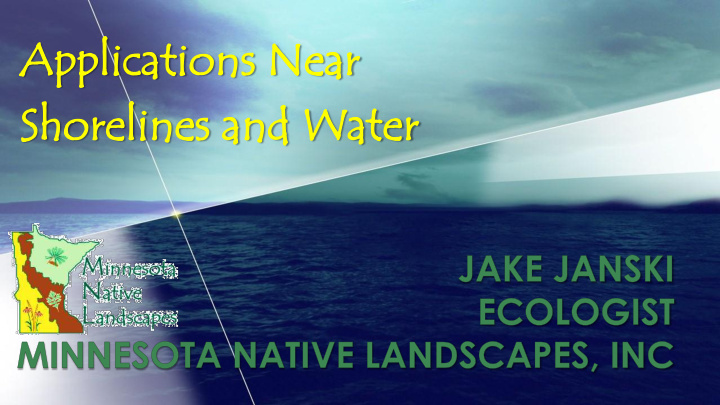



App Applica licati tions ons Ne Near ar Sh Shorel oreline ines s an and Wa d Wate ter
Shorelines : The interface between land and (big) water • Lakes, streams, ponds and rivers • Includes (native) terrestrial and emergent vegetation
Shorelines :
Shorelines : Similar “shoreline” conditions can often occur in: • Ditches or grass waterways • Wetlands, bogs or fens • Floodplains
Shorelines :
Shoreline Vegetation's Functions : The interface between land and water Provides protection to the Waterbody • Reduces surface runoff • Captures contaminates
Shoreline Vegetation's Functions : The interface between land and water Provides protection to the Land • Absorbs summer wave energy • Flood control • Mitigates ice impacts
Shoreline Vegetation's Functions : The interface between land and water Provides protection to Wildlife • Terrestrial Corridors (ag areas) • Water Access (for drinking or cleaning) • Offspring Protection (terrestrial and aquatic)
Shoreline Vegetation Management Vegetation control goals • Site prep- Shoreline restorations • Native species enhancement- Habitat improvement • Specific habitat creation- Pollinator habitat • Noxious weed control- Applicable laws • Woody species control- Improved site lines • Recreational access- Beaches and docks
Shoreline Vegetation Management IPM • May be more important in shorelines areas than it is in any other environment. • Drinking water • Wildlife uses • Recreation • Human food sources
Shoreline Vegetation Management Herbicide applications • Where are you planning to apply? • Terrestrial • Emergent • Floating leaf • Submergent This is essential to determine IF you can make the application, and WHAT you need to use.
Shoreline Vegetation Management Herbicide applications • Where are you planning to apply? • Allowed in Cat J • Terrestrial • Emergent • Not allowed in Cat J • Floating leaf • Submergent
Shoreline Vegetation Management Herbicide applications • What are you going to apply? • Terrestrial areas • Any type of plant not in open water at the time • Also in a location where drift/overspray cannot contact open water • Wind, direction of spray, etc • Pesticides labeled for terrestrial sites should be used
Shoreline Vegetation Management Terrestrial Herbicide Applications • Non-aquatic pesticide labels may allow limited applications to areas where limited surface water is present. • Water created by management activities such as tire ruts. • Direct applications to snow/ice (“surface water”) is prohibited, though direct applications to cut stump may be allowed
Shoreline Vegetation Management Herbicide applications • What are you goingto apply? • Emergent areas • Any type of plant found in open water at the time • Or plants in a location where drift/overspray could contact open water • Pesticides labeled for aquatic sites MUST be used
Shoreline Vegetation Management Includes seasonally or temporarily flooded areas
Shoreline Vegetation Management Aquatic Herbicide applications • Know what the label allows and/or requires • Some product labels include both terrestrial and aquatic uses Aquatic Herbicide options • Non- selective- glyphosate, diquat • Selective- 2, 4-D, triclopyr, dicamba, etc Plan for the unexpected • If potential for standing water exists, plan to use something labeled for both to avoid delays during the application.
Shoreline Vegetation Management Shoreline Herbicide Applications • Know what the label allows and/or requires • Read carefully both the “Directions for Use” AND “Environmental Hazards” sections. • Keep in mind certification requirements if you will be making applications directly to the water- Category F
Shoreline Vegetation Management Herbicide application methods • Spray- best for site prep and broad application of selective herbicide, or spot spraying to reduce impacts. • If using on emergent vegetation, spray toward shoreline, not into waterbody • Wick- avoid drift or off-target concerns • Granular (into the water)- Not Allowed in Cat J
Shoreline Vegetation Management Other considerations • Permitting. • DNR permit needed when controlling emergent vegetation • Check with the County or other local municipalities for additional requirement
Shoreline Vegetation Management Other considerations • Recreational Use • Plan your applications accordingly to avoid conflicts with swimmers, boaters, hunters, fishermen or other recreational users of the resource.
Shoreline Vegetation Management Other considerations • Species ID: shorelines contain many lookalikes. • Native verses hybrid cattail species • Reed canary grass and Canada bluejoint • Buckthorn species and alder • Blue flag and yellow flag Iris
Shoreline Vegetation Management Other considerations • Soil disturbances • These applications often occur in very sensitive areas with saturated soils. • Avoid rutting or adversely impacting the soil and non target vegetation
Shoreline Vegetation Management Unfortunately, **IT happens
Shoreline Vegetation Management Other considerations • Public Perceptions • Minnesotans take their water very seriously! • Know what you are doing, what you are using and why! • An applicator making a concerted effort to use the smallest quantity of the safest herbicide possible, helps give the public confidence in the professionalism of our industries.
QUESTIONS??
Recommend
More recommend